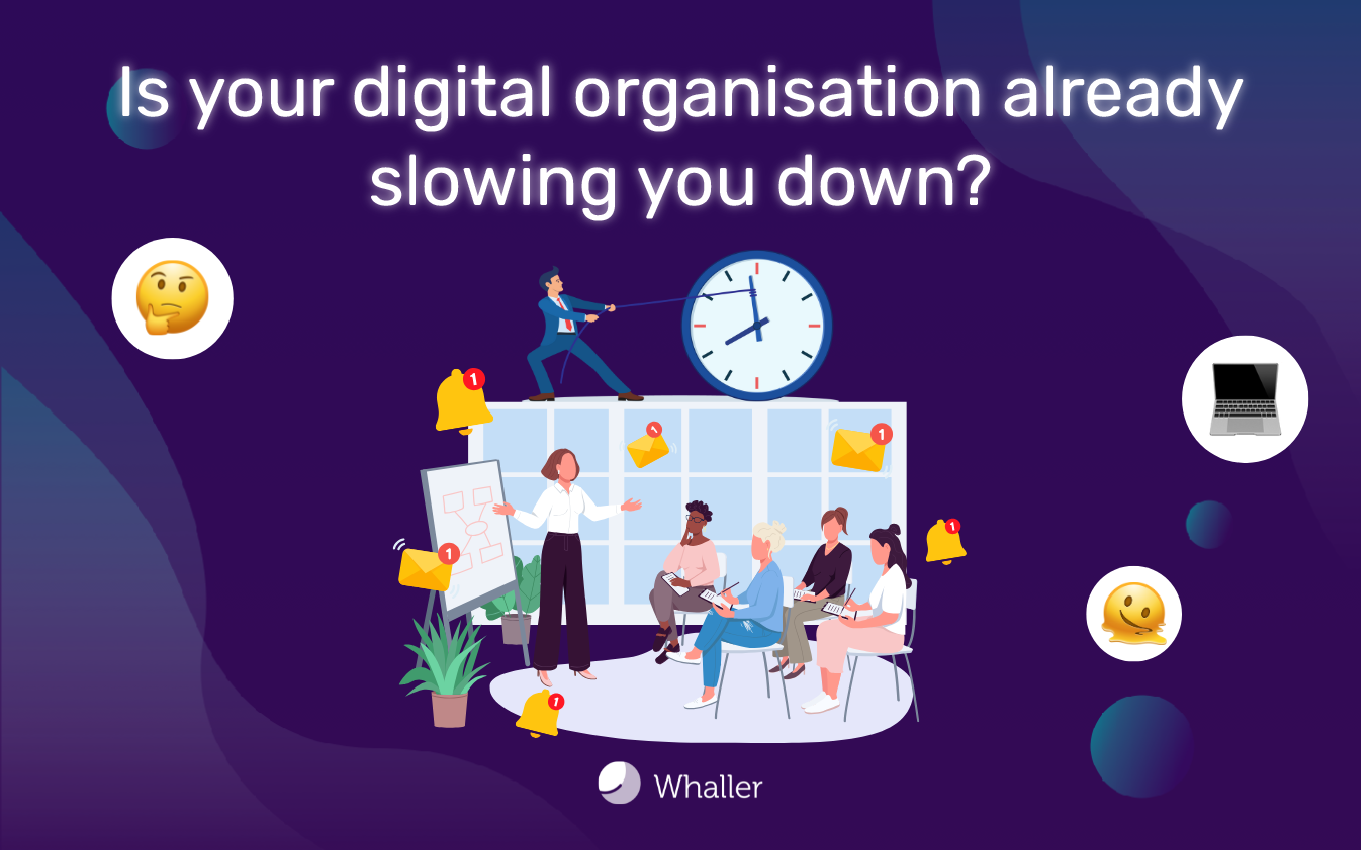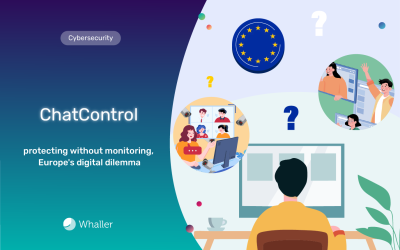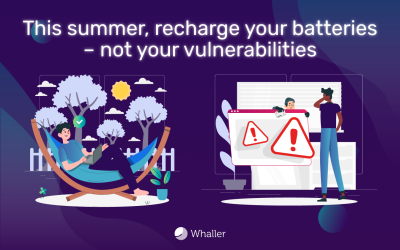Faced with an overload of digital tools and the growing disorganisation of communication, we’re sharing our internal best practices to simply collaborate better.
In a professional life saturated with notifications, duplicated files, and endless meetings, it’s easy to lose sight of the essential: working better together isn’t about accumulating tools; it’s about learning to use them better.
It was with this in mind that we at Whaller took a step back to analyze our uses, our digital habits… and our failures. We brought our teams together, compared our practices, and then decided to formalize what we would have liked to read or hear sooner: simple, applicable, and realistic rules to restore order to collaboration.
Too many tools, too much noise, not enough action
Despite the goodwill of our teams, digital work has become a veritable minefield. Between the numerous exchanges, missing files, and constant alerts, concentration is becoming scarce and fatigue is setting in. We’re not the only ones to have observed this, but we’ve decided to structure our response, at our level, with our tools. And to make it a model that everyone can adopt, in their own context.
Five Simple (But Powerful) Practices
1. One Project = One Discussion
Rather than multiplying emails, scattered messages, or improvised “quick updates,” we centralize exchanges into structured discussions within thematic areas. This allows everyone to know where the conversation is going, find information… and breathe.
No need for long email chains or chat novels:
- A dedicated sphere in Whaller.
- A clear, contextual message.
- An @mention if necessary.
Information neatly organized, in the right place, at the right time.
2. Well-named files = a team that breathes
Between Whaller Drive and our File Box, we’ve implemented simple rules: legible, dated, and versioned names. This isn’t about policing; it’s about mutual respect. Finding the right document at the right time is also about creating a good work environment.
Whaller Drive, File Box, clear tree structures: it’s not a luxury, it’s a matter of collective survival.
- Name your files properly: “20250313_Plan_com.pdf”, not “nouveau_doc_OK_vf”.
- Distinguish between source, export, and archive files.
- Make what needs to be accessible to the team. Nothing is more frustrating than a file that can’t be found… or renamed by mistake.
3. Meetings are not collective punishment
A meeting only makes sense if it’s necessary, prepared, and structured. Otherwise, it’s exhausting without producing anything. We’ve learned to do fewer of them, but better. And sometimes, a good message in instant messaging (Discussions at Whaller) conducted well is worth ten video calls.
A good meeting:
- Starts on time.
- Has an agenda.
- Ends in less than 45 minutes.
- Delivers concrete actions.
Otherwise? A well-written message is better.
4. Unclear tasks never get done
We use our task management tool for what it is: a shared framework for action. Everyone can create tasks, assign them (including to their superiors), and track their progress. It’s direct, clear, and efficient.
On Whaller, you can create tasks and assign them clearly.
- To a colleague.
- To your manager.
- To yourself.
No need to beat around the bush. If you’re expecting an action, formulate it as such. Otherwise, it won’t materialize.
5. Less noise, more focus
Respecting digital silence also means respecting other people’s time. Fewer unnecessary notifications, fewer unnecessary reminders, more peace of mind. An unspoken rule that has become essential.
Every notification too many is one more distraction.
- Enable useful notifications.
- Respect the right to focus.
- Don’t send an umbrella email just to “cover up.”.
Digital noise is the new silent exhaustion. Fighting it means preserving our abilities.
It’s not a tool, it’s a framework
At Whaller, we believe that technology only makes sense if it serves a clear purpose, a team culture, and a shared ambition. It’s not about “transforming everything,” but simply about collaborating better. Day after day. Document after document.
And you?
Whether you’re a community, a business, or a school, these practices are yours if you choose to make them your own. We share them for what they are: live, imperfect, but useful feedback.
And if you were to ask yourself a few (more) questions…
“Okay for a startup, but in a city hall or government department… really?”
The following example is, let’s admit, fictitious. But it very well could not be.
Imagine a medium-sized local authority in which the urban planning department juggles dozens of projects, scattered documents, and email exchanges every week, the latest version of which no one really knows. One day, this department decided to structure its projects in Whaller, creating a dedicated sphere, a well-organized document space, and a discussion thread per topic. The DGS, initially skeptical, realized he could validate a document without having to search for it in his inbox. The local elected official discovered, to his surprise, that he could track the progress of a file without having to call three people. The moral of this story (imaginary, but credible) is that digital transformation is not a question of size or perceived modernity, but of shared will and appropriate use.
“I’m convinced, but my colleagues won’t necessarily follow…”
It’s a legitimate fear, one we often hear: “Why should I do it if others won’t?”
But experience shows that adopting a new way of working never starts with everyone at the same time. It begins with one person daring to properly create a task and another asking a question in a chat rather than in a group email. And soon, a response. Then a reaction. Then a department manager taking the time to comment. It’s these micro-changes, barely noticeable at the time, that ultimately transform a team culture. And it always starts with someone daring to initiate, without waiting for a collective green light.
“I understand the idea, but assigning a task to my line manager seems risky…”
Indeed, this may seem unusual. But it’s often a question of stance and wording. In a supportive environment, taking action in a collaborative space, in a clear and contextualized manner, isn’t a sign of audacity, but of rigor. Your manager may fully appreciate that a file requires approval, that you specify the expectations, and that you set a reasonable deadline.
This isn’t an order; it’s a decision-making aid.
And sometimes, a superior will thank you for saving them from an oversight. Which, upon reflection, is perfectly human.
“All this seems relevant to me, but I need a hand getting started.”
This is precisely why we’ve designed an environment to be progressive, accessible, and reassuring.
Whether you’re new to Whaller or a regular user, you’ll find:
- Simple video tutorials, designed to guide you step by step without technical jargon
- A clear help center, designed for non-expert users
- Whaller (AI)ssistant, a sovereign AI assistant that guides you without analyzing your data
- And above all, a support team in France that’s available, human, and at your service. Listen
Because we believe that collaboration isn’t decreed, but built. And that you have the right to move forward at your own pace, without pressure or judgment.
📅 Sign up for free and discover Whaller I 👉 Request a demo I 📩 Need advice? Contact us!





0 Comments